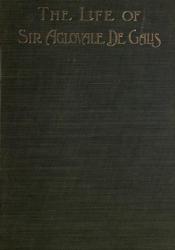Clemence Housman publishes The Life of Sir Aglovale de Galis
In her third and final novel, Clemence Housman offers a modern take on Arthurania with her adaptation of the life of Sir Aglovale de Galis, the eldest son of King Pellinore and a Knight of the Round Table (Reynolds 208). Housman draws from Sir Thomas Malory’s collection of Arthurian tales, Le Morte d’Arthur, using her artistic license to fill in the gaps Malory leaves in Aglovale’s life (Reynolds 208). Like The Were-Wolf, Housman uses Christian allegory and a balance between sin and virtue as a thematic background to her narrative. The novel’s front matter contains a segment of the eleventh chapter of the Theologia Germanica, an anonymous Christian treatise discovered by Martin Luther in the sixteenth century (Newman 658-9). The excerpt describes man’s despair at how far he has fallen from God’s grace. Because he desires nothing more than the Eternal Good, he is granted access to the kingdom of heaven. This passage is an appropriate preface to Aglovale’s journey; the knight, while sinful, unfailingly admits to his faults. Aglovale is ultimately imprisoned, but his honesty earns him a sense of moral redemption.
Detaching herself from the narrative style of her previous novels, The Were-Wolf and The Unknown Sea, Housman adopts Malory’s archaic prose, prompting some negative reviews from the few critics to analyze Aglovale de Galis (Kleis 120). Others, like longtime friend of the Housmans Reginald Reynolds, called it “the most amazing book [he’d] ever read” (208). In spite of this, Aglovale de Galis struggled to gain traction in the literary realm. Like The Were-Wolf, Aglovale de Galis was reissued under several different publishers, starting with Meuthen Publishing Ltd. in London in 1905. Prodded by Laurence Housman, Clemence’s novel was reprinted under independent publisher Jonathan Cape a year before her death in 1954 (Reynolds 208).
Clemence dedicated the novel to her brother Robert Holden Housman, who died in May of 1905, four months before Aglovale de Galis was first published in September of that year. The inscription reads: “Thanks be to God for my good brother, who has blessed this life of mine.” The Life of Sir Aglovale de Galis lies is a final testament to Clemence's careful and suspenseful prose.

